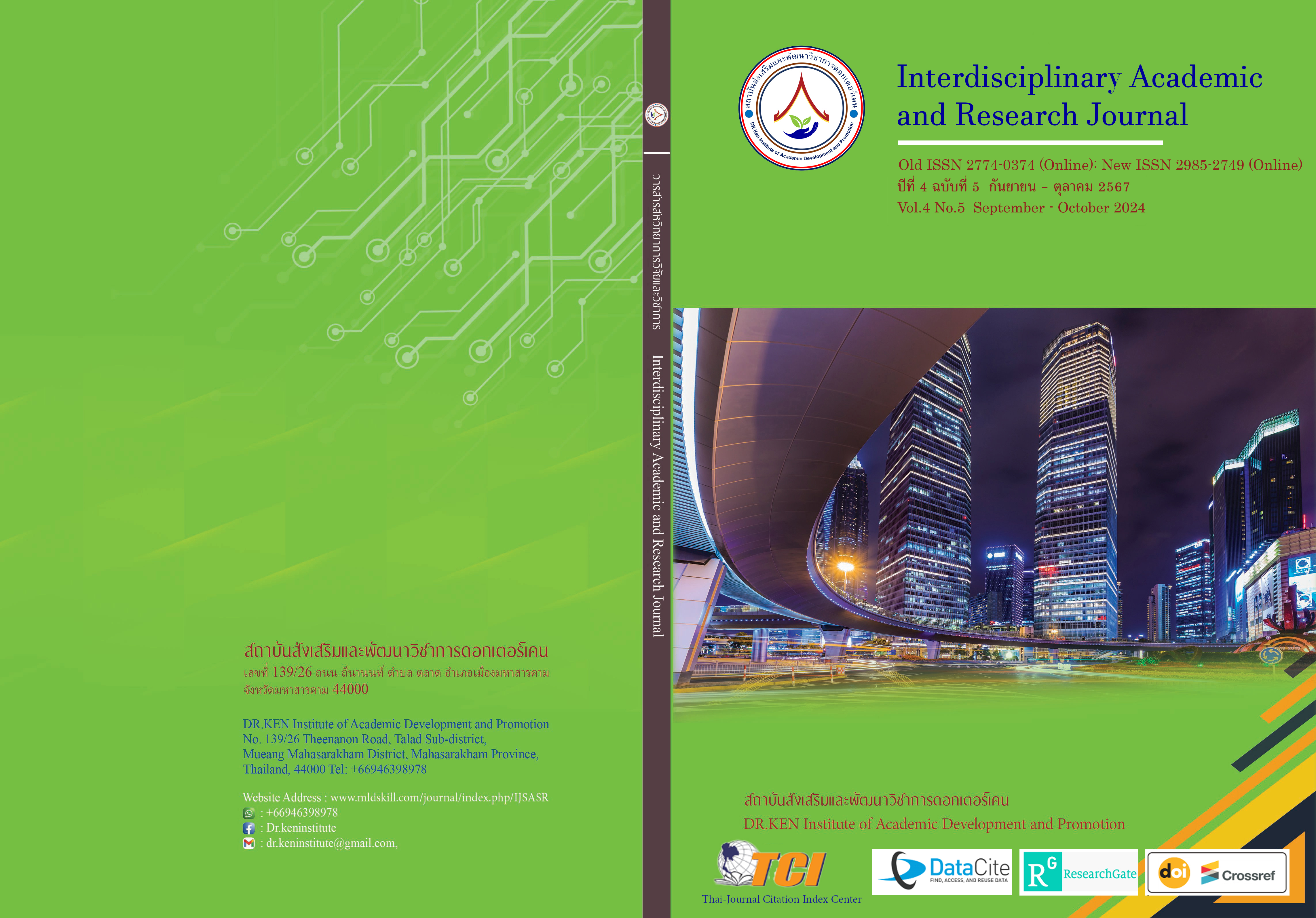Development of Training Curriculum on Using English for Pre-service Teachers Aligned with the Common European Framework of Reference for Languages (CEFR)
DOI:
https://doi.org/10.60027/iarj.2024.277871Keywords:
Training Curriculum;, Using English; , Common European Framework of Reference for Languages (CEFR)Abstract
Background and Aims: This research aims to enhance effectiveness in teaching and learning English. This research aimed to 1) study the basic information and training needs, 2) develop a training curriculum, 3) implement the training curriculum, and 4) evaluate the effectiveness of the English language training program for teacher students, aligned with The Common European Framework of Reference for Languages (CEFR). The research was conducted in four phases: 1) studying the basic information and training needs, 2) developing the training curriculum, 3) implementing the training curriculum, and 4) evaluating the effectiveness of the English language training program for teacher students according to The Common European Framework of Reference for Languages (CEFR).
Methodology: The population consisted of 120 third and fourth-year English major students from the Faculty of Education, Rajabhat Maha Sarakham University. The sample used for studying the basic information and training needs in the first phase included 92 third and fourth-year students. The target group for the focus group discussions consisted of 9 English Lecturers, while the sample for the interviews included 20 third and fourth-year English major students from the Faculty of Education, selected through purposive sampling. The second phase's informants were 7 experts and professionals. The target group for implementing and evaluating the training program consisted of 30 English major students from the Faculty of Education, at Rajabhat Maha Sarakham University, and 7 experts, selected through purposive sampling. Research tools included questionnaires, interviews, the training curriculum, tests, satisfaction surveys, and an efficiency evaluation form for the curriculum. Statistical analysis methods included percentage, mean, standard deviation, t-test (dependent), and One Sample test.
Results: (1) The condition and demand for English language development according to the European Union's language framework were at a moderate level, while the demand for developing English language skills among teacher students was at the highest level. (2) The developed training curriculum consisted of 7 components: 1) background and importance of the problem, 2) curriculum principles, 3) objectives, 4) content, 5) training activities, 6) training media, and 7) evaluation and assessment. The overall appropriateness of the curriculum was rated at the highest level. (3) The implementation of the developed training curriculum showed that students' test scores significantly improved after training at the .01 level, and teacher students who completed the training could pass the RMU_UET exam by the International Relations and Educational Management Office of Rajabhat Mahasarakham University, with 73% passing. Overall satisfaction with the training activities was rated at the highest level. (4) The assessment results of the training curriculum's development included the context, input, process, and product evaluations, with an overall high rating. Evaluation by individual aspects revealed high ratings in all aspects.
Conclusion: In summary, the research findings demonstrate that the developed training curriculum for enhancing English proficiency among students and pre-service teachers based on the Common European Framework of Reference for Languages (CEFR) is effective and enables using the curriculum effectively.
References
ขันแก้ว มาพรม. (2564). การพัฒนาหลักสูตรฝึกอบรมเพื่อส่งเสริมการจัดการเรียนรู้ภาษาอังกฤษเพื่อการสื่อสารโดยบูรณาการอาเซียนศึกษาสำหรับครูประถมศึกษา. วิทยานิพนธ์ปริญญาครุศาสตรดุษฎีบัณฑิต, มหาวิทยาลัยราชภัฏมหาสารคาม.
ณดา บิลดาวูด. (2560). การพัฒนาหลักสูตรฝึกอบรมเพื่อยกระดับทักษะภาษาอังกฤษตามกรอบอ้างอิงทางภาษาของสหภาพยุโรปของนักเรียนระดับชั้นประถมศึกษาปีที่ 6. วารสารศึกษาศาสตร์ มหาวิทยาลัยทักษิณ, 17(1), 1-15. สืบค้นจาก https://so02.tci-thaijo.org/index.php/eduthu/article/view/96225
ธำรง บัวศรี. (2532). ทฤษฎีหลักสูตรการออกแบบและพัฒนา. กรุงเทพฯ: คุรุสภาลาดพร้าว.
บุญชม ศรีสะอาด. (2553). การวิจัยเบื้องต้น. พิมพ์ครั้งที่ 7. กรุงเทพฯ : สุวีริยาสาน์ส.
ประชาชาติธุรกิจ. (2560). การศึกษา: EF ดัชนีภาษาอังกฤษ ไทยควรเพิ่มทักษะการสื่อสาร. ประชาติธุรกิจออนไลน์. 8 ธันวาคม 2560. https://www.prachachat.net/education/news-84621
รุ่งทิวา จันทน์วัฒนวงษ์. (2557). เอกสารประกอบการสอน รายวิชาการพัฒนาหลักสูตร : Curriculum Development. คณะครุศาสตร์ มหาวิทยาลัยราชภัฏอุดรธานี.
ลักษณ์พร เข้มขัน และ จิติมา วรรณศรี. (2564). รูปแบบการพัฒนาสมรรถนะของครูภาษาอังกฤษในสถานศึกษา สังกัดสำนักงานคณะกรรมการการศึกษาขั้นพื้นฐาน. วารสารศึกษาศาสตร์ มหาวิทยาลัยนเรศวร, ปีที่ 23(4), 298-309.
วารุณี อัศวโภคิน. (2554). การพัฒนาหลักสูตรฝึกอบรมการใช้ภาษาอังกฤษเพื่อการสื่อสาร ของบุคลากรสายสนับสนุนวิชาการ มหาวิทยาลัยศรีนครินทรวิโรฒ. ปริญญานิพนธ์การศึกษาดุษฎีบัณฑิต สาขาวิชาการศึกษาผู้ใหญ่ มหาวิทยาลัยศรีนครินทรวิโรฒ ประสานมิตร.
วิจารณ์ พานิช. (2555). วิถีสร้างการเรียนรู้เพื่อศิษย์ในศตวรรษที่ 21. กรุงเทพฯ : มูลนิธิสดศรี-สฤษดิ์วงศ์.
วิชัย วงษ์ใหญ่. (2554). กระบวนการพัฒนาหลักสูตรและการเรียนการสอน : ภาคปฏิบัติ.กรุงเทพฯ : สุวีริยาสาสน์.
สงัด อุทรานันท์. (2532). เทคนิคการจัดการเรียนการสอนอย่างเป็นระบบ. พิมพ์ครั้งที่ 6. กรุงเทพฯ: มิตรสยาม.
สถาบันทดสอบทางการศึกษาแห่งชาติ (องค์การมหาชน). (2561). สรุปผลการทดสอบทางการศึกษาระดับชาติขั้นพื้นฐาน(O-NET) ชั้นมัธยมศึกษาปีที่6 ปีการศึกษา 2560. Retieved from: http://www.newonetresult.niets.or.th/AnnouncementWeb/PDF/SummaryONETM6_2560.pdf
สุภัทรา อักษรานุเคราะห์. (2532). การสอนทักษะทางภาษาและวัฒนธรรม. กรุงเทพฯ: คณะครุศาสตร์. จุฬาลงกรณ์มหาวิทยาลัย.
สุมิตร คุณานุกร. (2533). หลักสูตรและการสอน. พิมพ์ครั้งที่ 4. กรุงเทพฯ: ศึกษิตสยาม.
สุรางค์ โค้วตระกูล. (2541). จิตวิทยาการศึกษา. กรุงเทพฯ: จุฬาลงกรณ์มหาวิทยาลัย.
Ministry of Education (2014). Annual Report. Ministry of Education.
Oliva, P.F. (1992). Developing the Curriculum. Boston: Brown and Company.
Read, J. (2019). The influence of the Common European Framework of Reference (CEFR) in the Asia-Pacific Region. LEARN Journal: Language Education and Acquisition Research Network, 12, 12-18.
Saylor, J.G., & Alexander, M.W. (1974). Planning Curriculum for School. 3rd edition. New York: Holt Rinehart and Winston.
Stufflebeam, D.L. (1967). The CIPP model for program evaluation. In G. Madaus, M. Scriven, & D. Stufflebeam (Eds.), Evaluation models: Viewpoints on educational and human services evaluation (pp. 117-141). Kluwer Academic Publishers
Taba, H. (1962). Curriculum Development: Theory and Practice. New York: Harcourt, Brace, and World.
Tyler, R.W. (1949). Basic Principle of Curriculum and Instruction. Chicago; Thesunversity of Chicago.
Yu, L., Chen, M., Chiu, C., Hsu, C., & Yuan, Y. (2022). Examining English ability-grouping practices by aligning CEFR levels with university-level general English courses in Taiwan. Sustainability, 14(8), 4629.
Downloads
Published
How to Cite
Issue
Section
License
Copyright (c) 2024 Interdisciplinary Academic and Research Journal

This work is licensed under a Creative Commons Attribution-NonCommercial-NoDerivatives 4.0 International License.
Copyright on any article in the Interdisciplinary Academic and Research Journal is retained by the author(s) under the under the Creative Commons Attribution-NonCommercial-NoDerivatives 4.0 International License. Permission to use text, content, images, etc. of publication. Any user to read, download, copy, distribute, print, search, or link to the full texts of articles, crawl them for indexing, pass them as data to software, or use them for any other lawful purpose. But do not use it for commercial use or with the intent to benefit any business.
















.png)


